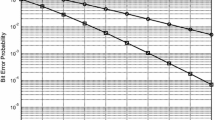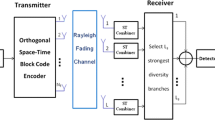Abstract
Generalized channel fading distributions such as κ–μ and η–μ are well suited for modelling various fading channels as they fit well to the experimental data. This paper is concerned with the performance analysis of orthogonal space–time block-codes system using M-ary Phase shift keying/quadrature amplitude modulation with antenna selection over generalized η–μ fading channel i.e., for non-line-of-sight applications. We derive the closed form expression of the average bit error rate by employing “moment generating function” based approach for different modulation schemes. Simulation results are finally presented to demonstrate the correctness of theoretical analysis by assuming different values for η and μ, where each value corresponds to different channels. The impact of actual number of antennas, i.e., number of antennas before antenna selection, were also shown.






Similar content being viewed by others
References
Alamouti, S. M. (1998). A simple transmit diversity technique for wireless communications. IEEE Journal on Selected Areas in Communications, 16(8), 1451–1458.
Tarokh, V., Seshadri, N., & Calderbank, A. R. (1998). Space-time codes for high data rate wireless communication: Performance criterion and code construction. IEEE Transactions on Information Theory, 44(2), 744–765.
Tarokh, V., Jafarkhani, H., & Calderbank, A. R. (1999). Space–time block codes from orthogonal designs. IEEE Transactions on Information Theory, 45(5), 1456–1467.
Su, W., & Xia, X. G. (2003). On space-time block codes from complex orthogonal designs. Springer Wireless Personal Communications, 25(1), 1–26.
Hochwald, B. M., & Marzetta, T. L. (1999). Capacity of a mobile multiple antenna communication link in Rayleigh flat fading. IEEE Transactions on Information Theory, 45(1), 139–157.
Telatar, I. E. (1999). Capacity of multi-antenna Gaussian channels. European transactions on telecommunications, 10(6), 585–595.
Bhashyam, S., Sabharwal, A., & Aazhang, B. (2002). Feedback gain in multiple antenna systems. IEEE Transactions on Communications, 50(5), 785–798.
Yoo, T., & Goldsmith, A. J. (2004). Capacity of fading MIMO channels with channel estimation error. In IEEE International Conference on Communications, ICC’04, Vol. 2, pp. 808–813.
Raju, M. S., Annavajjala, R., & Chockalingam, A. (2006). BER analysis of QAM on fading channels with transmit diversity. IEEE Transactions on Wireless Communications, 5(3), 481–486.
Shin, H., & Lee, J. H. (2002). Exact symbol error probability of orthogonal space-time block codes. In IEEE Global Telecommunications Conference, GLOBECOM ‘02, pp. 1192–1201.
Simon, M. K. (2001). Evaluation of average bit error probability for space time coding based on a simpler exact evaluation of pairwise error probability. Journal of Communication Networks, 3(3), 257–264.
Taricco, G., & Biglieri, E. (2002). Exact pairwise error probability of space-time codes. IEEE Transactions on Information Theory, 48(2), 510–513.
Conti, A., Win, M. Z., Chiani, M., & Winters, J. H. (2003). Bit error outage for diversity reception in shadowing environment. IEEE Communication Letters, 7(1), 15–17.
Vielmon, A., Li, Y., & Barry, J. R. (2004). Performance of Alamouti transmit diversity over time-varying Rayleigh-fading channels. IEEE Transactions on Wireless Communications, 3(5), 1369–1373.
Gore, D., & Paulraj, A. (2002). MIMO antennas subset selection with space–time coding. IEEE Transactions on Signal Processing, 50(10), 2580–2588.
Zeng, X., & Ghrayeb, A. (2004). Performance bounds for space–time block codes with receive antenna selection. IEEE Transactions on Information Theory, 50(9), 2130–2137.
Sanayei, S., & Nosratinia, A. (2004). Antenna selection in MIMO systems. IEEE Communications Magazine, 42(10), 74–80.
Zeng, X., & Ghrayeb, A. (2004). Antenna selection for space–time block codes over correlated Rayleigh fading channels. IEEE Canadian Journal of Electrical and Computer Engineering, 29(4), 219–226.
Wing, H. W., & Larsson, E. G. (2003). Orthogonal space–time block coding with antenna selection and power allocation. IET Electronics Letters, 39(4), 379–381.
Chen, Z., Yuan, J., Vucetic, B., & Zhou, Z. (2003). Performance of Alamouti scheme with transmit antenna selection. IET Electronics Letters, 39(23), 1666–1668.
Love, D. (2005). On the probability of error of antenna-subset selection with space–time block codes. IEEE Transactions on Communications, 53(11), 1799–1803.
Chen, C., Sezgin, A., Cioffi, J., & Paulraj, A. (2008). Antenna selection in space–time block coded systems: Performance analysis and low-complexity algorithm. IEEE Transactions on Signal Processing, 56(7), 3303–3314.
Zhang, W., & Tellambura, C. (2010). Performance analysis of joint transmit and receive antenna selection with orthogonal space–time coding. IEEE Transactions on Vehicular Technology, 59(5), 2631–2635.
Gucluoglu, T., & Duman, T. M. (2007). Performance analysis of transmit and receive antenna selection with space–time coding. In IEEE International Conference on Communications, ICC’07, pp. 5305–5310.
Wei, Z., Tellambura, C., & Xinwei, D. (2007). Space–time coded systems with joint transmit and receive antenna selection. In IEEE Global Telecommunications Conference, GLOBECOM ‘07, pp. 3519–3523.
Gucluoglu, T., & Duman, T. M. (2008). Performance analysis of transmit and receive antenna selection over flat fading channels. IEEE Transactions on Wireless Communications, 7(8), 3056–3065.
Torabi, M. (2008). Antenna selection for MIMO-OFDM systems. Signal Processing, 88(10), 2431–2441.
Torabi, M., & Conan, J. (2015). Performance analysis of orthogonal space–time block coding with antenna selection. IET Communications, 9(10), 1298–1305.
Yacoub, M. D. (2007). The κ-μ distribution and the η-μ distribution. IEEE Antennas and Propagation Magazine, 49(1), 68–81.
Badarneh, O. S., & Mesleh, R. (2016). Cooperative dual-hop wireless communication systems with beamforming over fading channels. IEEE Transactions on Vehicular Technology, 65(1), 37–46.
Peña-Martín, J. P., Romero-Jerez, J. M., & Tellez-Labao, C. (2015). Performance of selection combining diversity in η–μ fading channels with integer values of μ. IEEE Transactions on Vehicular Technology, 64(2), 834–839.
Mesleh, R., Badarneh, O. S., Younis, A., & Haas, H. (2015). Performance analysis of spatial modulation and space-shift keying with imperfect channel estimation over generalized fading channels. IEEE Transactions on Vehicular Technology, 64(1), 88–96.
Krithiga, S., Bhaskar, V., & Malarvizhi, S. (2016). Average channel capacity and bit error rate using threshold conditions for MIMO-OSTBC systems over η–µ fading channels. Wireless Personal Communications 1–19. doi:10.1007/s11277-016-3659-0.
Yang, J., Chen, L., Lei, X., Peppas, K. P., & Duong, T. Q. (2016). Dual-hop cognitive amplify-and-forward relaying networks over η–μ fading channels. IEEE Transactions on Vehicular Technology, 65(8), 6290–6300.
Maruthu, S., Kamasani, C., & Palanivel, M. (2015). Performance analysis of multiple relay cooperative communication over generalized κ–μ and η–μ fading channels. AEU-International Journal of Electronics and Communications, 69(9), 1220–1225.
Kumar, P., & Dhaka, K. (2016). Performance analysis of a decode-and-forward relay system in κ–μ and η–μ Fading channels. IEEE Transactions on Vehicular Technology, 65(4), 2768–2775.
Torabi, M., Aissa, S., & Soleymani, M. (2007). On the BER performance of space-frequency block coded OFDM systems in fading MIMO channels. IEEE Transactions on Wireless Communications, 6(4), 1366–1373.
Proakis, J. G. (2001). Digital communications. New York: McGraw-Hill.
Ermolova, N. Y. (2008). Moment generating functions of the generalized η–μ and κ–μ distributions and their applications to performance evaluations of communication systems. IEEE Communications Letters, 12(7), 502–504.
Simon, M. K., & Alouini, M. S. (2005). Digital communications over fading channels: A unified approach to performance analysis (2nd ed.). New Jersey: Wiley.
Gentle, J. E. (2005). Random number generation and Monte Carlo methods (2nd ed.). Berlin: Springer.
Cogliatti, R., De Souza, R., & Yacoub, M. (2012). Practical, highly efficient algorithm for generating κ–μ and η–μ variates and a near-100 efficient algorithm for generating α–μ variates. IEEE Communication Letters, 16(11), 1768–1771.
Author information
Authors and Affiliations
Corresponding author
Rights and permissions
About this article
Cite this article
Surendar, M., Muthuchidambaranathan, P. Average BER Performance of Orthogonal Space–Time Block Coding System with Antenna Selection Over Generalized η–μ Fading Channel. Wireless Pers Commun 96, 1407–1418 (2017). https://doi.org/10.1007/s11277-017-4246-8
Published:
Issue Date:
DOI: https://doi.org/10.1007/s11277-017-4246-8




